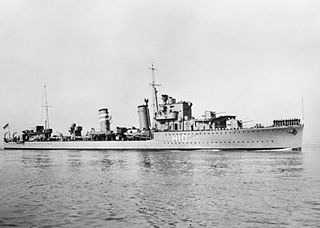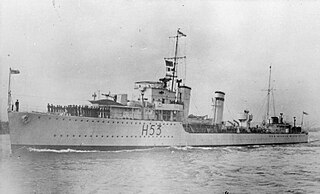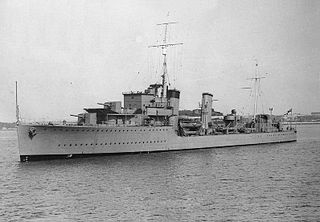
HMS Garland, also known by her Polish designation ORP Garland, was a G-class destroyer built for the Royal Navy in the mid-1930s. During the Spanish Civil War of 1936–1939 the ship spent considerable time in Spanish waters, enforcing the arms blockade imposed by Britain and France on both sides of the conflict. Shortly after World War II began, she was badly damaged by the premature explosion of her own depth charges and required over six months of repairs. Before these were completed, Garland was loaned to the Polish Navy in May 1940. The ship was assigned to the Mediterranean Fleet afterwards and escorted convoys there before being assigned to the Western Approaches Command in September for escort duties. She escorted a convoy from Gibraltar to Malta during Operation Halberd in September 1941 and escorted Convoy PQ 16 from Iceland to Murmansk in May 1942. She was badly damaged by a near miss from a German bomber during that operation and required three months of repairs.

HMS Hesperus was an H-class destroyer that had originally been ordered by the Brazilian Navy with the name Juruena in the late 1930s, but was purchased by the Royal Navy after the beginning of World War II in September 1939, commissioned in 1940 as HMS Hearty and then quickly renamed as Hesperus.

HMS Duncan was a D-class destroyer leader built for the Royal Navy in the early 1930s. The ship was initially assigned to the Mediterranean Fleet before she was transferred to the China Station in early 1935 where she remained until mid-1939. Duncan returned to the Mediterranean Fleet just after World War II began in September 1939. She was transferred to the Home Fleet in December 1939, although she was badly damaged in a collision the following month, and required repairs that lasted until July 1940. The ship joined Force H at Gibraltar in October, escorting the larger ships and various convoys until March 1941 when she was transferred to West Africa for convoy escort duties for a few months. Duncan rejoined the 13th Destroyer Flotilla at Gibraltar in July and escorted several convoys to Malta during the rest of the year. After a refit, she briefly returned to the 13th Destroyer Flotilla before joining the Eastern Fleet in the Indian Ocean to participate in Operation Ironclad in May 1942. The ship was recalled home to be converted into an escort destroyer in late 1942.

The C and D class was a group of 14 destroyers built for the Royal Navy in the early 1930s. As in previous years, it was originally intended to order a complete flotilla comprising eight destroyers—plus a flotilla leader as the ninth unit—in each year. However, only four ships—plus a leader—were ordered under the 1929–1930 Programme as the C class. The other four ships planned for the C class were never ordered as an economy measure and disarmament gesture by the Labour government of Ramsay MacDonald. A complete flotilla—the 'D' class—was ordered under the 1930–1931 Programme.

The E and F-class destroyers were a group of 18 destroyers built for the Royal Navy during the 1930s. The ships were initially assigned to the Home Fleet, although they reinforced the Mediterranean Fleet during the Italian invasion of Abyssinia of 1935–36 and enforced the Non-Intervention Agreement during the Spanish Civil War of 1936–1939. After the beginning of the Second World War in August 1939, the E-class ships were mostly assigned to escort duties under the Western Approaches Command, while the Fs were assigned to escort the ships of the Home Fleet. Between them they sank four German submarines through March 1940 while losing only one ship to a submarine.

HMS Bulldog (H91) was a B-class destroyer built for the Royal Navy (RN) between 1929 and 1931. Initially assigned to the Mediterranean Fleet, she transferred to the Home Fleet in 1936. During the Spanish Civil War of 1936–1939, the ship spent considerable time in Spanish waters, enforcing the arms blockade imposed by Britain and France on both sides of the conflict. Bulldog saw service throughout World War II on convoy escort duty during the Battle of the Atlantic and in the Arctic. Her most notable actions were the capture of an Enigma machine and codebooks from the U-110 in 1941, sinking another German submarine in 1944 and taking the surrender of the German garrisons on the Channel Islands on 9 May 1945. Surplus after the war, she was broken up for scrap in 1946.

HMS Tartar was a Tribal-class destroyer of the Royal Navy that saw service in most of the naval theatres of World War II. She had an eventful career, eventually receiving the nickname 'Lucky Tartar' due to her numerous escapes from dangerous situations. She was one of only four from the sixteen Royal Navy-operated Tribal-class destroyers to survive the war.

HMS Keith was a B-class destroyer flotilla leader built for the Royal Navy around 1930. Initially assigned to the Mediterranean Fleet, she was placed in reserve in 1937, after repairs from a collision were completed. During the Spanish Civil War of 1936–1939, the ship was reactivated and spent some time in Spanish waters, enforcing the arms blockade imposed by Britain and France on both sides of the conflict. Keith escorted convoys and conducted anti-submarine patrols early in World War II before being sunk at Dunkirk by German aircraft.

HMS Boadicea was a B-class destroyer built for the Royal Navy (RN) around 1930. Initially assigned to the Mediterranean Fleet, she was transferred to the Home Fleet in 1936. Before her departure, the ship evacuated civilians from Spain during the beginning of the Spanish Civil War of 1936–1939. Boadicea later spent considerable time in Spanish waters, enforcing the arms blockade imposed by Britain and France on both sides of the conflict. During World War II, the ship spent the bulk of the war on convoy escort duty in British waters and participated in the Battle of the Atlantic, Operation Torch, the Russian Convoys, and in the Normandy landings. Badly damaged by German dive bombers in 1940, she was sunk almost exactly four years later by German aircraft.

HMS Boreas was a B-class destroyer built for the Royal Navy around 1930. Initially assigned to the Mediterranean Fleet, she was transferred to the Home Fleet in 1936. She then patrolled Spanish waters, enforcing the arms blockade during the first year of the Spanish Civil War of 1936–1939. She spent most of World War II on convoy escort duties in the English Channel and the North Atlantic, based at Dover, Gibraltar, and Freetown, Sierra Leone. Boreas also participated in Operation Husky and was later loaned to the Royal Hellenic Navy the next year after conversion into an escort destroyer. She was renamed Salamis and served in the Aegean for the rest of the war. Salamis became a training ship after the war until she was returned to Britain and scrapped in 1952.

HMS Decoy was a D-class destroyer of the Royal Navy. Ordered in 1931, the ship was constructed by John I. Thornycroft & Company, and entered naval service in 1933. Decoy was initially assigned to the Mediterranean Fleet before she was transferred to the China Station in early 1935. She was temporarily deployed in the Red Sea during late 1935 during the Abyssinia Crisis, before returning to her duty station where she remained until mid-1939. Decoy was transferred back to the Mediterranean Fleet just before the Second World War began in September 1939. She briefly was assigned to West Africa for convoy escort duties in 1940 before returning to the Mediterranean. The ship participated in the Battles of Calabria without significant damage and escorted ships of the Mediterranean Fleet for most of the rest of the year.

HMS Escapade was an E-class destroyer built for the Royal Navy in the early 1930s. Although assigned to the Home Fleet upon completion in 1934, the ship was attached to the Mediterranean Fleet in 1935–1936 during the Abyssinia Crisis. During the Spanish Civil War of 1936–1939 she spent considerable time in Spanish waters, enforcing the arms blockade imposed by Britain and France on both sides of the conflict. Escapade was assigned to convoy escort and anti-submarine patrol duties in the Western Approaches when World War II began in September 1939, but transferred back to the Home Fleet at the end of the year.

HMS Escort was an E-class destroyer built for the Royal Navy in the early 1930s. Although assigned to the Home Fleet upon completion, the ship was attached to the Mediterranean Fleet in 1935–36, during the Abyssinia Crisis. During the Spanish Civil War of 1936–1939, she spent considerable time in Spanish waters, enforcing the arms blockade imposed by Britain and France on both sides of the conflict. Escort was assigned to convoy escort and anti-submarine patrol duties in the Western Approaches, when World War II began in September 1939. During the Norwegian Campaign, the ship escorted ships of the Home Fleet, although she did tow her sister HMS Eclipse after the latter ship had been badly damaged by German air attack. Escort was assigned to Force H in late June, and participated in the Attack on Mers-el-Kébir in early July. She was torpedoed a few days later by an Italian submarine, but was towed for three days towards Gibraltar before she foundered.

HMS Fame was an F-class destroyer built for the Royal Navy during the 1930s. Although assigned to the Home Fleet upon completion, the ship was attached to the Mediterranean Fleet in 1935–36 during the Abyssinia Crisis. During the Spanish Civil War of 1936–1939, she spent time in Spanish waters, enforcing the arms blockade imposed by Britain and France on both sides of the conflict. Fame served in the Norwegian Campaign in 1940 before she was severely damaged when she ran aground in October. The ship was refloated several months later and spent a year and a half under repair. Fame was converted into an escort destroyer while under repair and was assigned to escort duties in the North Atlantic when the repairs were completed in mid-1942.

HMS Harvester was an H-class destroyer originally ordered by the Brazilian Navy with the name Jurua in the late 1930s, but bought by the Royal Navy after the beginning of World War II in September 1939. Almost immediately after being commissioned, in May 1940, the ship began evacuating Allied troops from Dunkirk and other locations in France. Afterwards she was assigned to the Western Approaches Command for convoy escort duties. Harvester and another destroyer sank a German submarine in October. She was briefly assigned to Force H in May 1941, but her anti-aircraft armament was deemed too weak and she was transferred to the Newfoundland Escort Force in June 1941 for escort duties in the North Atlantic. The ship was returned to the Western Approaches Command in October 1941 and was converted to an escort destroyer in early 1942. Harvester was torpedoed and sunk in March 1943 by a German submarine after having rammed and sunk another submarine the previous day while escorting Convoy HX 228.

HMS Havelock was an H-class destroyer that had originally been ordered by the Brazilian Navy with the name Jutahy in the late 1930s, but was bought by the Royal Navy after the beginning of the Second World War in September 1939 and later renamed. She participated in the Norwegian Campaign in May 1940 and was assigned to convoy escort and anti-submarine patrols with the Western Approaches Command afterwards. The ship was briefly assigned to Force H in 1941, but her anti-aircraft armament was deemed too weak and she rejoined Western Approaches Command. Havelock became flotilla leader of Escort Group B-5 of the Mid-Ocean Escort Force in early 1942 and continued to escort convoys in the North Atlantic for the next two years. The ship was converted to an escort destroyer and sank one submarine during the war. After the end of the war, she escorted the ships carrying the Norwegian government in exile back to Norway and served as a target ship through mid-1946. Havelock was scrapped beginning in late 1946.

HMS Highlander was an H-class destroyer that had originally been ordered by the Brazilian Navy with the name Jaguaribe in the late 1930s, but was bought by the Royal Navy after the beginning of World War II in September 1939 and later renamed. When completed in March 1940, she was assigned to the 9th Destroyer Flotilla of the Home Fleet. The ship was assigned to convoy escort duties in June with the Western Approaches Command, sinking one German submarine in October. Highlander was transferred to Freetown, Sierra Leone, in mid-1941 to escort convoys off West Africa, but returned to the United Kingdom in August. She became flotilla leader of Escort Group B-4 of the Mid-Ocean Escort Force in early 1942 and continued to escort convoys in the North Atlantic for the rest of the war. The ship became a target ship after the war ended and was sold for scrap in mid-1946.

HMS Dainty was a D-class destroyer built for the Royal Navy in the early 1930s. The ship was initially assigned to the Mediterranean Fleet before she was transferred to the China Station in early 1935. She was temporarily deployed in the Red Sea during late 1935 during the Abyssinia Crisis, before returning to her assigned station where she remained until mid-1939. Dainty was transferred back to the Mediterranean Fleet just before World War II began in September 1939. She briefly was assigned to West Africa for convoy escort duties in 1940 before returning to the Mediterranean. The ship participated in the Battle of Calabria in July 1940 and was assigned to convoy escort and patrol duties until she was sunk by German bombers off Tobruk on 24 February 1941.

HMS Kempenfelt was a C-class destroyer built for the Royal Navy in the early 1930s. A flotilla leader, she saw service in the Home Fleet before World War II and the ship made several deployments to Spanish waters during the Spanish Civil War, enforcing the arms blockade imposed by Britain and France on both sides of the conflict.

HMS Douglas was an Admiralty type flotilla leader of the British Royal Navy. Built by Cammell Laird, Douglas commissioned in 1918, just before the end of the First World War. During the Second World War, Douglas served with Force H out of Gibraltar and as a convoy escort. She was sold for scrap in March 1945.




















